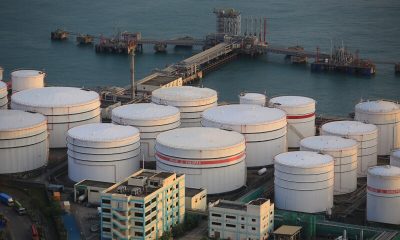Commodities
Oil moves higher on debt ceiling progress, positive Chinese data

Oil prices rose in Asian trade on Thursday, rebounding from near one-month lows as investors cheered progress towards averting a U.S. debt default, while signs of life in Chinese manufacturing also brewed some optimism over a demand recovery in the country.
Markets took some relief from the U.S. House of Representatives voting in favor of a bill to suspend the debt ceiling, moving it forward to the Senate for a vote later this week.
The move comes just days before a June 5 deadline for a U.S. default, although the bill’s progression in the Senate marks a positive step towards avoiding such a scenario.
Also supporting oil markets was a private survey that showed China’s manufacturing sector grew more than expected in May. The reading was in contrast to an official survey, which showed on Wednesday that manufacturing activity contracted in May, although the divergence likely came from a difference in scope between the two surveys.
Thursday’s data indicated that activity among smaller, private Chinese manufacturers was improving, which could herald a broader recovery as the country reemerges from three years of strict anti-COVID lockdowns.
Still, the survey also noted that economic growth in the country remained under pressure, which, coupled with a string of weak readings for April, tempered optimism over a Chinese recovery in oil demand.
The positive signals largely offset industry data pointing to an unexpected build in U.S. oil inventories over the past week, which cooled bets on improving fuel demand in the country.
Brent oil futures rose 0.7% to $73.09 a barrel, while West Texas Intermediate crude futures rose 0.6% to $68.50 a barrel.
Concerns over slowing demand in China, coupled with pressure from a stronger dollar, had battered oil prices on Wednesday, pushing both major contracts to four-week lows.
But the dollar eased from 10-week highs on Thursday, after some Federal Reserve officials touted a potential pause in rate hikes during the central bank’s June meeting to take stock of monetary policy tightening over the past year.
Focus is now chiefly on nonfarm payrolls data for May, due this Friday, for more cues on monetary policy. Fears of higher for longer U.S. interest rates had weighed on crude prices through May.
Uncertainty over more production cuts by the Organization of Petroleum Exporting Countries (OPEC) also kept crude markets on edge, ahead of a meeting between members of the cartel this weekend. Russian and Saudi Arabian ministers had offered differing views on future production cuts.
Commodities
Oil prices rise; U.S. crude inventories plunge, Russia-Ukraine truce eyed
Commodities
India’s Reliance to stop buying Venezuelan oil over US tariffs, sources say
Commodities
Oil prices climb on Venezuela supply worries

 Forex3 years ago
Forex3 years agoForex Today: the dollar is gaining strength amid gloomy sentiment at the start of the Fed’s week

 Forex3 years ago
Forex3 years agoUnbiased review of Pocket Option broker

 Forex3 years ago
Forex3 years agoDollar to pound sterling exchange rate today: Pound plummeted to its lowest since 1985

 Forex3 years ago
Forex3 years agoHow is the Australian dollar doing today?

 Cryptocurrency3 years ago
Cryptocurrency3 years agoWhat happened in the crypto market – current events today

 World3 years ago
World3 years agoWhy are modern video games an art form?

 Commodities3 years ago
Commodities3 years agoCopper continues to fall in price on expectations of lower demand in China

 Economy3 years ago
Economy3 years agoCrude oil tankers double in price due to EU anti-Russian sanctions



































